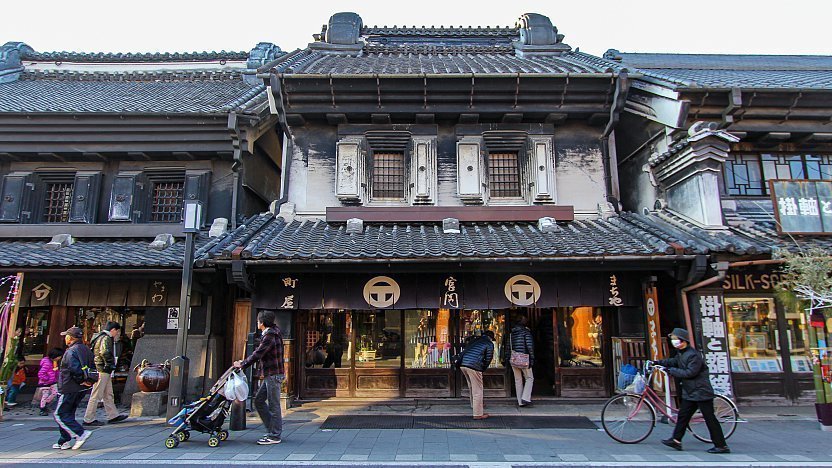Warehouse District

Kawagoe's Warehouse District (蔵造りの町並み, Kurazukuri no Machinami) provides a nostalgic scene from the Edo Period (1603-1867). The word "kura" means "warehouse" in Japanese, and Kurazukuri are clay-walled warehouse-styled buildings that are constructed with an Edo architectural flavor.
In the old days, Kawagoe was an important commercial town supplying resources to Edo (present day Tokyo). Thanks to the thriving trade, many merchants grew wealthy enough to build not only their warehouses but also their stores in the Kurazukuri style, more so than it was usual in other towns. Some of the buildings managed to survive to this day. Mostly housing shops and restaurants, they can be found along the main Kurazukuri Street which stretches a few hundred meters long. Heavy regular car traffic along the street, however, takes away a lot of the historic atmosphere and limits pedestrians to narrow sidewalks.

In the past, Japanese cities consisted almost exclusively of wooden buildings, which made them vulnerable to fires. Kurazukuri construction was used both to make a structure fireproof and to secure it against intruders. They were very expensive to build, as their construction involved making thick walls consisting of several layers. Thanks to the prosperous trade with Edo, the merchants of Kawagoe flourished, and many showed their wealth by building as good-looking a structure as they could afford.
Just a short distance from the main street stands the Bell Tower (時の鐘, Toki no Kane), a landmark and symbol of Kawagoe. It chimes four times a day (6:00, 12:00, 15:00 and 18:00). The tower was rebuilt in 1894, after the Great Kawagoe Fire of 1893 had destroyed the previous structure.

One of the houses which is open to the public is the Museum of Kurazukuri (currently closed indefinitely for renovations). The museum is housed in what used to be a tobacco wholesaler's shop. Visitors can have a closer view of what a Kurazukuri building looks from the inside beyond the store front. Some of the exhibits include traditional machines used in the past. The museum is located along the main street.
A minute's walk away is the Candy Alley (Kashiya Yokocho). It is a wonderful place for trying some traditional Japanese sweets, while experiencing an ambience of past decades. Named after the Taisho Period (1912-1926), the Taisho-roman Street is located between Hon-Kawagoe Station and the Warehouse District. The Taisho-styled architecture adds character to the walk towards the Kurazukuri.

The Kawagoe Festival started more than 360 years ago and is celebrated annually for two days on the third weekend of October in the Warehouse District. It is the festival of the nearby Hikawa Shrine and involves the parading of tall, elaborately decorated floats through the streets of the city.
For those who would like have a feel of the festival but are not able to visit Kawagoe at the time, a visit to the Kawagoe Festival Museum provides a glimpse of the experience. It houses a couple of the floats and puts on periodical shows to simulate the atmosphere of the festival.

Getting there and around
The Warehouse District can be reached in a 10-15 minute walk along the main street from Hon-Kawagoe Station. It takes about an additional ten minutes from Kawagoe Station or an additional five minutes from Kawagoe-shi Station.
How to get to and around Kawagoe

Hours and Fees
Museum of Kurazukuri
Closed
Festival Museum
Hours
Admission ends 30 minutes before closing time.
Closed
Admission
Questions? Ask in our forum.